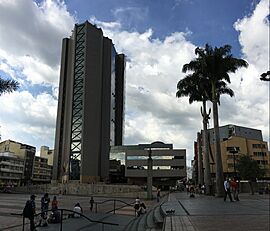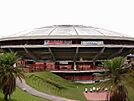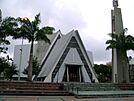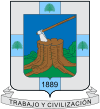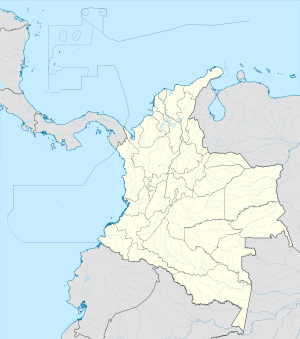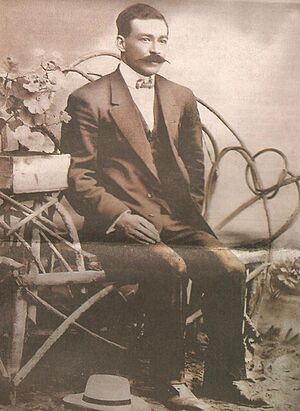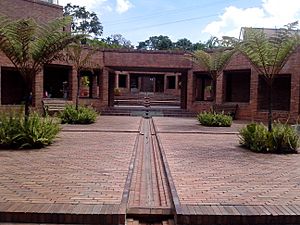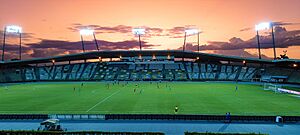Armenia, Colombia facts for kids
Quick facts for kids
Armenia
|
|||
|---|---|---|---|
|
City
|
|||
|
From above and from left to right: Bolivar Square, Armenia Upper River, Coffe Colliseum, Cathedral, North of Armenia.
|
|||
|
|||
| Nickname(s):
Ciudad Milagro (Miracle City)
|
|||

Location of the city and municipality of Armenia in the Quindío Department
|
|||
| Country | Colombia | ||
| Region | Andes Region | ||
| Departamento | Quindío | ||
| Founded | 1889 | ||
| Area | |||
| • City | 140 km2 (50 sq mi) | ||
| Elevation | 1,551 m (5,089 ft) | ||
| Population
(2018)
|
|||
| • City | 304,314 | ||
| • Density | 2,170/km2 (5,630/sq mi) | ||
| • Urban | 296,259 | ||
| • Metro | 514,604 | ||
| Demonym(s) | Armenita, Armenio(a) | ||
| GDP | |||
| • Metro | COP 11,942 billion (US$ 2.8 billion) |
||
| Time zone | UTC-05 (Eastern Time Zone) | ||
| Area code(s) | +57 (+6) | ||
| Website | Government website | ||
Armenia is the capital city of the Quindío Department in Colombia, a country in South America. It's a medium-sized city and an important part of the "coffee axis" region. This area is famous for growing coffee.
Armenia is one of the main centers for Colombia's economy, especially for coffee. Because of its importance in coffee growing, the historic center of Armenia was recognized by UNESCO as a World Heritage Site in 2011. This means it's a special place that is important to the world's history and culture.
Contents
History
Armenia was founded on October 14, 1889. The person who started the city was Jesús María Ocampo. People called him "Tigrero," which means "tiger killer," because he loved hunting jaguars.
Ocampo came from a place called Anaime, looking for a safe spot in the mountains of Quindío. He bought land to build a fonda, which was a trading center. This center was for himself and other settlers coming from different towns like Salento and Manizales. To encourage more people to settle, Ocampo sold land to them.
In August 1890, just six months after it started, Armenia had 100 people. This allowed it to be officially recognized by the government. When the city was founded, some suggested naming it Villa Holguín after the president at the time. But this idea was rejected. The name Armenia was chosen on November 30, 1889.
Some people think the city was named after the country Armenia to remember people who were killed there. However, these events happened *after* the city was already named Armenia. It's more likely that the early settlers, like in other new towns, chose names from the Bible.
Even though Armenia's economy grew quickly, travel was hard. People and goods were mostly moved by mules because of the mountains. Things got better in 1927 when the first paved road was built.
The 1999 Earthquake
On January 25, 1999, a strong earthquake hit Quindío. It had a magnitude of 6.2. The earthquake's center was about 17 kilometers south of Armenia.
This earthquake was one of the most damaging events in Colombia's recent history. About 1,900 people lost their lives. While the earthquake was felt in other areas, Armenia was hit the hardest. Despite the damage, the city was rebuilt in just 15 years. Today, it is a popular place for tourists to visit in Colombia.
Geography
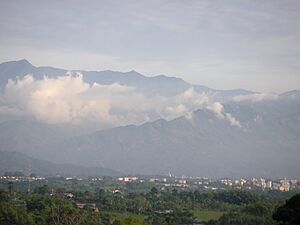
Armenia is located about 290 kilometers west of Bogotá. It sits at an elevation of 1,483 meters above sea level. The city covers an area of about 121 square kilometers.
Armenia is bordered by other towns:
- To the north: Circasia and Salento.
- To the west: Montenegro.
- To the east: Calarcá.
- To the south: La Tebaida.
The city is near the center of the Cordillera mountain range. The weather in Armenia varies, with average temperatures usually between 16 and 23 degrees Celsius.
Climate
| Climate data for Calarcá/Armenia, elevation 1,450 m (4,760 ft), (1981–2010) | |||||||||||||
|---|---|---|---|---|---|---|---|---|---|---|---|---|---|
| Month | Jan | Feb | Mar | Apr | May | Jun | Jul | Aug | Sep | Oct | Nov | Dec | Year |
| Mean daily maximum °C (°F) | 25.6 (78.1) |
25.9 (78.6) |
26.1 (79.0) |
25.1 (77.2) |
25.0 (77.0) |
25.3 (77.5) |
25.9 (78.6) |
26.3 (79.3) |
25.6 (78.1) |
24.6 (76.3) |
24.7 (76.5) |
25.1 (77.2) |
25.4 (77.7) |
| Daily mean °C (°F) | 20.6 (69.1) |
20.9 (69.6) |
20.9 (69.6) |
20.7 (69.3) |
20.6 (69.1) |
20.9 (69.6) |
21.1 (70.0) |
21.2 (70.2) |
20.4 (68.7) |
19.9 (67.8) |
19.9 (67.8) |
20.2 (68.4) |
20.6 (69.1) |
| Mean daily minimum °C (°F) | 16.1 (61.0) |
16.4 (61.5) |
16.5 (61.7) |
16.7 (62.1) |
16.6 (61.9) |
16.4 (61.5) |
16.1 (61.0) |
16.2 (61.2) |
16.0 (60.8) |
16.0 (60.8) |
16.1 (61.0) |
16.0 (60.8) |
16.2 (61.2) |
| Average precipitation mm (inches) | 166 (6.5) |
137.8 (5.43) |
229.9 (9.05) |
253.0 (9.96) |
203.9 (8.03) |
85.0 (3.35) |
67.6 (2.66) |
86.5 (3.41) |
140.8 (5.54) |
253.7 (9.99) |
313.1 (12.33) |
222.3 (8.75) |
2,159.5 (85.02) |
| Average relative humidity (%) | 81 | 80 | 80 | 83 | 83 | 81 | 77 | 77 | 81 | 83 | 83 | 82 | 81 |
| Mean monthly sunshine hours | 130.2 | 115.7 | 133.3 | 99.0 | 108.5 | 126.0 | 145.7 | 148.8 | 120.0 | 99.2 | 108.0 | 130.2 | 1,464.6 |
| Mean daily sunshine hours | 4.2 | 4.1 | 4.3 | 3.3 | 3.5 | 4.2 | 4.7 | 4.8 | 4.0 | 3.2 | 3.6 | 4.2 | 4.0 |
| Source: Instituto de Hidrologia Meteorologia y Estudios Ambientales | |||||||||||||
Economy
Armenia is often called "Ciudad Milagro," which means "Miracle City." This nickname comes from how fast the city has grown and developed. The city center has a nine-block long walking area with shops and restaurants.
The local economy still mainly relies on growing coffee, plantains, and bananas.
South of the city, where it's warmer, the climate is good for farming. It also helps a growing tourism industry. You can find villas for rent, theme parks, eco-hotels, and family fun centers. There are also local restaurants, exhibition centers, and country clubs for sports like fishing, tennis, and golf. Many traditional coffee farms in the area offer places to stay and "ecotourism" trips.
The city has a modern international airport called El Edén International Airport. It has daily flights to major cities like Bogotá and Medellín, and even to Panama City and Fort Lauderdale. This makes Armenia a good place for meetings and events.
Transport
Armenia is part of a program called "friendly cities." This program aims to make public transportation better in the country's main cities.
Armenia has its own plan called the Strategic Public Transport System. This program is run by a company called Friendly Company, which was created to manage the project.
The Strategic Public Transport System is part of a bigger national plan. It helps improve public transport in medium-sized cities with fewer than 400,000 people. It helps organize and manage the city's transport system better.
Three main city transport companies joined together to form a new transport operator called TINTO. TINTO stands for "Transporte Integrado Operador de Armenia," which means "Integrated Transport Operator of Armenia." This new company shows a new image to its citizens, using the coffee icon of the city.
Some of this information comes from the Armenia Friendly program website.
El Edén International Airport is about 10 kilometers from the city. It is located on the road to the town of La Tebaida.
Tourism and Folklore
The growing tourism in Armenia has made the city and its surrounding areas more popular. The northern part of the region is the entry point to Los Nevados National Natural Park. Here, you can see some of the highest peaks in central Colombia, with snow all year round.
Near this national park is the Cocora Valley. This valley is home to the wax palm, which is the National Tree of Colombia. The town of Salento in this valley is a popular tourist spot. It's known for its delicious fried river trout, crafts made from guadua (a strong native bamboo cane), and art galleries. Many artists live there. Tourists and hikers often start their trips to the national park from Salento.
The region's traditions and folklore are shown during many town festivals. Here are a few examples:
- The Yipao (Parade of Jeeps): After World War II, Armenia received Jeep vehicles. These were used for the difficult mountain roads. Now, these old Jeeps are part of a traditional parade. They carry huge loads of coffee, local farm products, and people.
- The Chapoleras beauty pageant: This event features costumes that look like the traditional coffee harvesting clothes from the late 1800s. The dances are famous throughout the country.
- Orchid Show: Every fall, La Asociacion Quindiana de Orquideologia hosts an orchid show. It is open to everyone. Judges from Colombia and sometimes from the American Orchid Society judge the beautiful orchids.
Art and Handcrafts
In the early 1900s, this region was known for making storage containers. These were made from the dried shells of a local fruit called "Cuyabra" or "totumo." This is why people born in Armenia are sometimes called "cuyabros." Today, these containers are not made for everyday use because plastic is cheaper. However, these traditional containers are still made and hand-painted as art.
The Carriel is a traditional leather handbag. It is a symbol of the Paisa culture and the early settlers from Antioquia. It is often used in traditional dances and parades. Smaller versions are sold to tourists as souvenirs. You can also see handicrafts made from cabuya, which is a type of natural fiber.
The guadua bamboo is widely used in Armenia. It is used to create art, furniture, and even buildings.
Education and Sports
The main sports places in Armenia are the Centenario Stadium and the Coliseo del cafe (Armenia, Colombia). Here, you can watch local sports events, including national and international football games. The city's professional football team, Deportes Quindío, plays here. Other popular sports include golf, swimming, and cycling. The mountains around Armenia have helped produce some of the world's best climbing cyclists. Many of them compete in international events like the Tour de France.
The local university in the city is the University of Quindío. Its campus is in the north of the city. It is the most important place for education and research in Armenia and the entire department.
The Quimbaya museum, designed by Rogelio Salmona, has a permanent display of ancient handcrafts, pottery, and gold art pieces.
Sister cities
Colombia:
See also
 In Spanish: Armenia (Quindío) para niños
In Spanish: Armenia (Quindío) para niños


